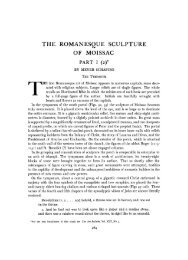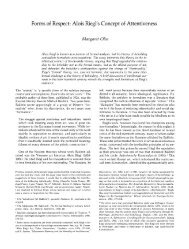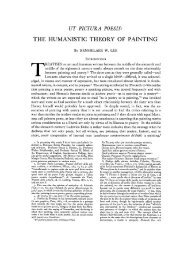Tragic Pompeii - College Art Association
Tragic Pompeii - College Art Association
Tragic Pompeii - College Art Association
Create successful ePaper yourself
Turn your PDF publications into a flip-book with our unique Google optimized e-Paper software.
250 THE ART BULLETIN JUNE<br />
2<br />
1994 VOLUME LXXVI NUMBER 2<br />
6l1pcanemhigenaa<br />
-I<br />
Amazon frieze masks landscapes<br />
Phrixos Narcissus a<br />
S6a 6b 6<br />
M,<br />
Amphitrite & Achilles 6&<br />
_0Poseidon Agamemnon<br />
T Briseis & Helen<br />
I I I<br />
S6 12phgena<br />
-Alcestis &<br />
0 6 1 m ITheseuse<br />
14a' 14b16<br />
2<br />
HOUSE OF THE TRAGIC POET, POMPEII VI.8.3<br />
33 Plan showing locations of all figural scenes found in the house<br />
of love or honor.55 The compositional parallel between the<br />
naked figures of Iphigenia in the peristyle and Amphitrite<br />
back in the atrium (Fig. 26), both shown in the moment of<br />
being carried off, reinforced the persistent contrast within<br />
the house of exposed and confined women. There were<br />
other connections. Iphigenia, like Helen, was Argive; the<br />
sacrifice of her body to <strong>Art</strong>emis secured Greek success in the<br />
Trojan War; ostensibly, she died in order to save another<br />
woman, Helen. But her death was also a "maker of quarrels,"<br />
for it brought down her father, Agamemnon, the king of the<br />
Greeks.<br />
That same king could be seen in the atrium quarreling<br />
over the fate of still another woman, Briseis. The analogy<br />
55The digitally reconstructed photo in Fig. 32 originated in two<br />
separate 35mm slides, one of the site and the other of the panel in<br />
Naples. Both slides were scanned and then imported into Boston Photo<br />
Lab's Kodak Premier Image Enhancement System. From here the two<br />
images were combined by digital artist John McKnight and then output<br />
on LVT high-resolution film recorder as a 4 x 5mm transparency.<br />
between Iphigenia and Briseis is made by Achilles himself<br />
when, after reconciling with Agamemnon, he wishes Briseis<br />
had died like Iphigenia rather than cause a fight between<br />
men: "Agamemnon-was it better for both of us, after all, for<br />
you and me to rage at each other, raked by anguish,<br />
consumed by heartsick strife, all for a young girl? If only<br />
<strong>Art</strong>emis had cut her down at the ships-with one quick<br />
shaft-that day I ... chose her as my prize." Agamemnon<br />
blames their quarrel on Zeus, Fate, and Fury, and especially<br />
on Ruin, the eldest daughter of Zeus; even Zeus, he says, was<br />
blinded by Ruin in the form of Hera's guile, "feminine as she<br />
is." Achilles agrees, addressing the god directly: "Father<br />
Zeus, great are the blinding frenzies you deal out to men! If<br />
not, I swear, Atrides could never have roused the fury in me,<br />
the rage that would not die, or wrenched the girl away<br />
against my will."56 In the epic context, the traffic in women<br />
56 lzad 19.56-60; 86-94, trans. Fagles, 490-491, 497.










